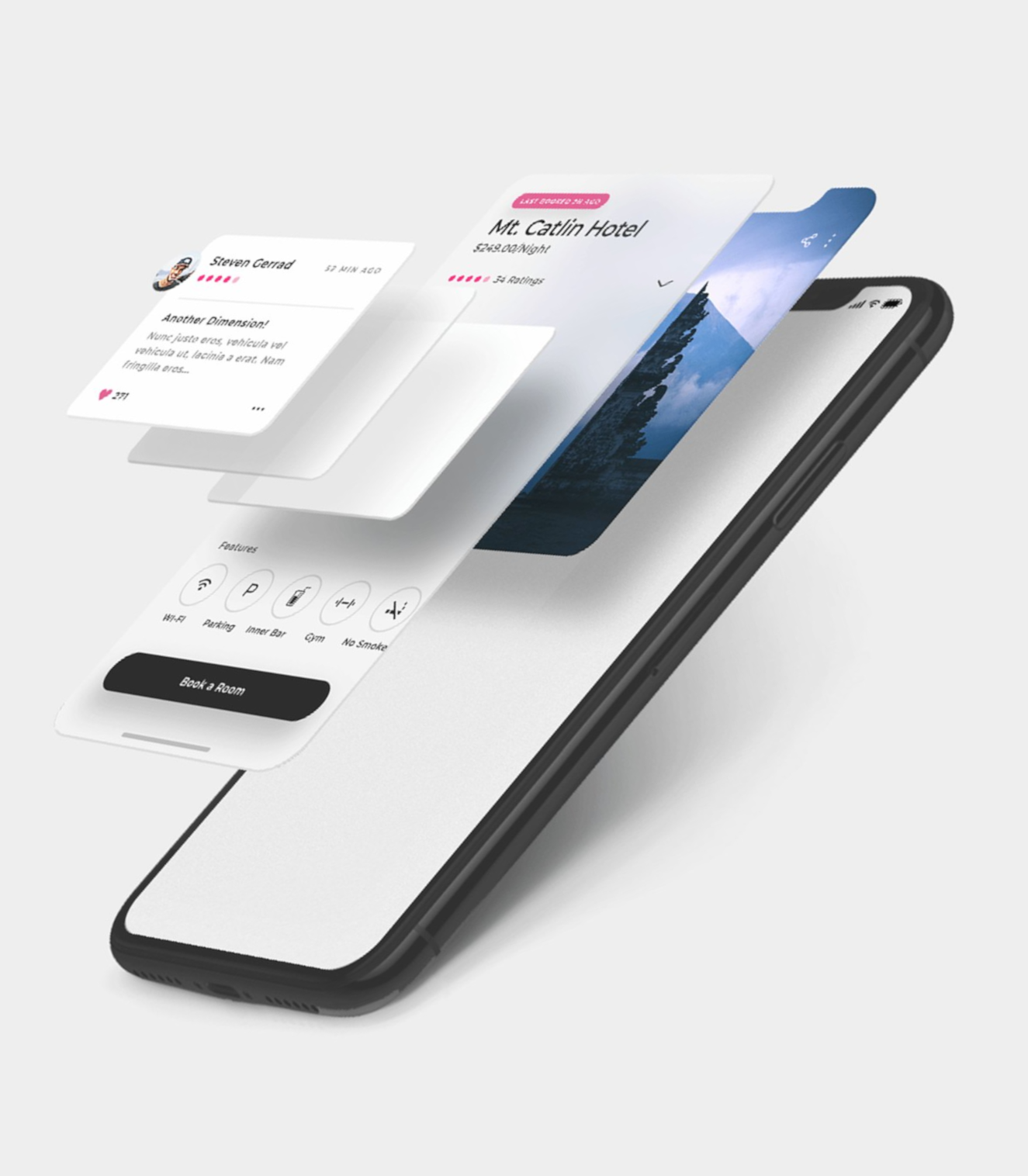
BY PETER HONNOR, PRODUCT DIRECTOR - STEER73
Should I Buy or Build a Solution?
Buy or Build – it’s a fundamental question at the beginning of any digital transformation project. At Steer73, clients approach us with a variety of challenges – ranging from initial business challenges, early product or solution ideas, right through to fully specified solutions that are ready to be created and adopted. As part of this process, the question of “Should we buy something off the shelf” or “Should we build our own application or service” is often raised early on, and here at Steer73, we have great insight into when a client should buy a solution and when its best to build their own.
How do you make this decision?
In summary, by asking the right questions. We find it helps by starting with the origins of any great digital solution, the intersection between 3 key areas: 1. What a business needs 2. What users expect/demand 3. What the available technology is best placed to deliver This framework holds true when deciding whether you are best served by building your own solution or buying off-the-shelf. So, let’s take a deeper look at each of these areas and how they influence the decision to buy or build.
1. What the business needs
When thinking about what is best for a business and the creation of their own digital platform, one of the first things we highlight with clients is the need for genuine buy in and commitment from the wider business. It cannot be underestimated the level of commitment needed to create, manage and support a bespoke internal platform. This may sound like a big undertaking, but the advantages of owning a platform can be immeasurable. We often ask clients to examine the following questions to help give direction to their thinking:
What is the nature of the problem you are trying to solve? Have similar companies solved this before? Have your direct or indirect competitors created their own solution or purchased in a software platform?
Are there any commercial considerations in utilising a 3rd party platform that will impact your overall commercial growth and profit? For example, as you scale do the 3rd party charges increase or decrease? Is there a per transaction cost? At what point does a 3rd party system no longer become cost effective?
How embedded in your processes must your new digital tool, platform or system be?If they need to be heavily embedded, how bespoke or custom are your internal processes?
What internal delivery support and technology teams are currently within your business?Are they able to take on a new application and work closely with vendors to support its release and ongoing maintenance?
What level of reporting is required across your business to continuously support your wider business goals and plans?
How important is your brand presence across your digital platforms?Are you taking this solution to not only your internal users, but also your customers? If your solution will be customer facing, can an off the shelf solution be customised with your brand experience to the point that it offers true differentiation from your competitors?
How will your chosen solution support your growth plans?Is it agile enough to support any immediate growth right now?
Is the potential off the shelf solution agile and flexible enough to allow you to experiment and innovate with new products, services and technologies?
Finally, and most importantly, how does the solution not only need to fulfil your requirements now, but also for the next 3 – 5 years?
By working through these questions, we are often able to quickly identify whether the commercial goals are best met with an internal build or an externally purchased digital solution.
- “The most successful digital experiences are those that are the personification of a client’s brand – and quite simply, white labelled solutions often don’t offer the level of customisation needed to deliver this."
2. What users expect/demand
The next area we focus on is the user base for the technology. There are a few key factors here, particularly around the level of experience customisation and differentiation required to effectively convey your brand. Brand experience plays a huge part when deciding whether to build a customised platform, as we often find that the only way to deliver a client’s brand experience and promise is to build a bespoke solution. At Steer73, we believe that the most successful digital experiences are those that are the personification of a client’s brand – and quite simply, white labelled solutions often don’t offer the level of customisation needed to deliver this. Moving on from the branding experience challenges, once again, running through a series of questions can help develop an understanding of what the right solution is for your users.
Who are your users, what are their expectations? What other systems, tools and apps do they use on a regular basis? If they use your competitor's apps and solutions, how will they recognise your brand with a similar experience?
What technology do your users use? Are they more focused on Web or App experiences? If they are App users, what is the split across Android and iOS? Can your chosen solution rapidly scale and offer the same experience and user journey across both platforms?
What is your end to end user journey? How bespoke is this journey and how unique is it to your business?
What level of reporting and insights are required from your end to end user journey? We should consider not only the quantitative factors such as conversions, revenue, etc, but also the qualitative insights about how satisfied your users are, where they seem to drop off, and how happy they are with your brand experience. This cannot be underestimated, as the constant cycle of Insights > Improvements > Insights > Improvements must be consistently fed with high-quality reporting and insights.
Will your chosen solution enable you to open your experience to new user groups, new markets, regions and locations?
Do your users have any specific accessibility needs that need to be met by your chosen solution?
Delivering a unique and successful brand experience to your users is often key to making the choice between building your own bespoke solution or buying and customising an off the shelf product. It is your brand experience that will deliver the key point of differentiation between you and your competitors, and this will ultimately drive growth and success. Can this be trusted to a 3rd party, one size kind of fits all solution?
3. What is the available technology best placed to deliver
Finally, looking at Technology, the key difference between a built and a bought solution is the ability to be fully supported and integrated into your existing technical architecture. Many of our clients engage with Steer73 with legacy systems and applications, often deeply routed and embedded in their organisational processes and operation model. Frequently, it is the legacy technical infrastructure that can cause the biggest challenges for new solutions to be added. Often, due to the nature and age of the legacy systems, an off the shelf solution being added and integrated simply isn’t technically viable. To get a strong understanding of the recommended direction, here are some questions we frequently work through with clients:
What is the technical configuration and toolset of your existing infrastructure? Can this be scaled and adapted to integrate into a new 3rd party solution?
What are your plans for your technical infrastructure in the next 3 – 5 years? Is the future state known, and can a purchased solution also fit into these plans?
What technical monitoring and reporting is required by the business?
What are the KPIs and SLAs that must be met to keep business critical processes running? Is the external solution capable of delivering these?
What does your current technical team look like? Is the external solution capable of delivering these?Do they have the right skills, understanding, assets and resources to correctly support a new solution?
Are there any regulatory requirements that must be technically adhered to due to the nature of your business?
The Technical questions we work through require significant consideration from key members of the technical team, often overseen by our CTO, working closely with a client’s CTO.
So how does all of the above manifest itself in the clients we engage with here at Steer73?
There are two very recent examples that we can look to that highlight how the decision to Buy or Build was heavily influenced by the key points above.

Recently, we engaged with a large manufacturer who was looking to streamline and transform their inventory system. They had a large number of products and wider company product lines that needed to be effectively managed when being sold through their dealers. During our Discovery activities, it quickly became clear that this was a challenge that had been solved many, many times before and there were effective systems that could be purchased and adapted to their need. The client's branding requirements were relatively minimal, and the end-users would be able to complete their goals and tasks on the already designed and implemented applications. So in this instance the decision was made to purchase an off the shelf solution and configure it to their needs. This was the right decision for their business, their users and the technology was easy to manage through the 3rd party vendor. This can be compared to our long standing relationship with a restaurant chain, creating and managing their apps and services that end users order and purchase their deliveries through. The food space is very interesting, as there are a number of large scale aggregators for food ordering and delivery - JustEat, Deliveroo and UberEats, to name a few. So why would a retailer choose to build their own application and services? Again, the answer to this lies in the intersection between Business, User and Technology needs. From a business perspective, creating their own app means significant investment, part of which can be offset against the aggregator fees and regular expenses. Our client's business is growing – rapidly, and they are not only increasing the amount of store locations they offer, but also the service lines and menu items offered to customers. By building and owning their own platform, they are able to rapidly change, update and experiment with new products and services, moving quicker and with more insight than their competitors. We are able to build flexibility and innovation into our product roadmap, and inherently instil the reporting and analytical tools required to not only support key business decisions, but to also create new insights to support the growth of their locations, services and product lines.

A quick example of this – it's relatively easy to understand which product line, at which store on any given day is the most popular. However, we are able to deliver further insights into how and why a particular dish is popular across their digital services. Was it because of a certain visual presentation of the dish, was it the way it was described, was it because we optimised the user's journey specifically to that dish, or because of how the chef at that certain location cooks the meal? Through our owned platform insights and reporting, we can gain deeper insights and understanding of how customers choose their items and ultimately drive to conversion, and this is then used across the entire digital and physical estate. It is this example that highlights how a truly customised and owned platform can, and should, be used as a tool to drive and support growth of the wider business. Looking to their user needs – as previously mentioned, our client's business is growing significantly and they are working hard to create clear brand and experience differentiation between themselves and their competitors. By building a custom solution, we can truly create a point of differentiation in our client's digital experiences that matches their brand across both their physical and digital estate. This will create two areas of growth for our client. First, existing users of the brand grow into loyal, committed and engaged customers. Second, new users instantly become part of a well planned and executed brand experience, enabling them to grow into repeat customers on quicker.
When looking at the overall UX of our platform – again, our insights and analysis tools within an owned platform truly allows us to deep dive into user goals, expectations and pain points through their digital experience. With these insights, we are able to constantly refine, update and optimise a user’s journey through the platform, leading not only to a better digital experience, but also increased conversion and average order spend. Finally, technology. The needs of our client’s business and users fundamentally drive the core requirement of a technology platform that is adaptable, scalable and that can be rapidly updated as per our client’s needs. Quite simply, nothing but an internally owned, managed and hosted technology platform would support our client’s key business goals, objectives and growth. Through our own technology platform, we are able to rapidly support the addition of new stores and engage with new technology partners to offer truly ground-breaking (i.e. drone delivery!) services. This technology approach will truly enable our client’s business growth and user engagement.
For both of these clients, we worked through our well documented and thought-through process to help them identify their needs and the subsequent steps required to resolve their original business challenge, requirement or goal. In some instances, during our Discovery activities, we find that an existing solution will fit their needs perfectly, and in some cases, a more bespoke, purpose-built solution is needed to fulfil their needs, not only now, but for their future business goals. Our key goal in Discovery is to help find the right solution for our clients, their business, their users and the technology that it must integrate into – and with both of these examples, I like to think we completed our original brief perfectly. Hopefully it can be seen that the question of “Should we buy something off the shelf” or “Should we build our own application or service” has many, many factors that influence the final decision.
At Steer73, we have the understanding, expertise, and experience to work with clients to not only help them decide if buying or building their own solution is the right direction to take, but also the skills and capabilities to help take any solution to launch. If you’d like to chat to us about any of the above, or to see how we might help you buy or build a solution – drop us a mail at karl@steer73.com

Input your search keywords and press Enter.